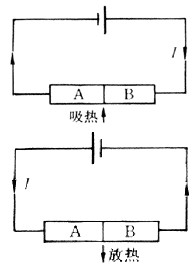1) thermoelectric films


温差电材料薄膜
1.
Bi2-xSbxTe3 thermoelectric films were prepared by potentiostatic electrodeposition.


采用电化学控电位沉积的方法制备了Bi2-xSbxTe3温差电材料薄膜。
2.
Bi_2Te_(3-y)Se_y thermoelectric films were prepared by potentiostatic electrodeposition on stainless steel and gold substrates.
采用控电位电沉积技术以不锈钢和金为基体制备了Bi2Te3-ySey温差电材料薄膜。
2) thermoelectric film


温差电材料薄膜
1.
Bi_2Te_(3-y)Se_y thermoelectric films were prepared by potentiostatic electrodeposition on stainless steel substrates.
采用电化学控电位的方法在不锈钢基片上电沉积制备了Bi2Te3-ySey温差电材料薄膜。
2.
Bi2Te3-ySey thermoelectric films were prepared by potentiostatic electrodeposition on stainless steel substrates, and the morphology, composition and structure of the films were characterized by ESEM, EDS and XRD.
采用电化学控电位沉积的方法在不锈钢基片上电沉积制备了Bi2Te3-ySey温差电材料薄膜,并采用ESEM、EDS、XRD等方法对电沉积薄膜的形貌、成分及结构进行了表征。
3) thin film TE material


薄膜温差电材料
1.
In the thesis, for the purpose of manufacturing of TE material and characterization of TE material, a set of electrodeposition device and thin film TE material resistivity measurement system are designed.
电沉积作为薄膜温差电材料的一种重要制备方法,日益受到关注,但由于这种方法的应用还处于初始阶段,其配套的制备设备及性能测试设备尚有待开发。
4) thermoelectric material


温差电材料
1.
New developing trend of thermoelectric materials;


温差电材料研究的新动向
2.
Doped with SbI 3 the pseudotermary n-type thermoelectric material (Bi 2Te 3) 0.


0 5赝三元 n型半导体温差电材料 ,测定了晶棒轴向温差电性能 。
3.
Low dimensional thermoelectric materials have attacted much attention due to their extensive application on pelter coolers and power generators.
低维温差电材料在温差制冷和温差发电方面展现的广阔应用前景引起了科学界的普遍关注。
5) thermoelectric materials


温差电材料
1.
Study on hot-pressing device used in thermoelectric materials;


温差电材料热压成形实验装置的研究
2.
The fabrication of thermoelectric nanowire is very important for the further improvement of the heat-electricity conversion efficiency of thermoelectric materials.
低维温差电材料具有比块状温差电材料更高的优值,因而研制具有纳米线阵列结构的温差电材料对于提高材料的温差电转换效率具有重要意义。
3.
Recently, the study on one-dimensional thermoelectric materials is getting more and more attention.
纳米线阵列结构温差电材料具有高的热电转换效率 ,非常适合制造输出功率在微瓦量级的微温差电池 。
6) thin-film electrode materials


薄膜电极材料
1.
Research progress on all solid-state thin-film lithium battery and thin-film electrode materials;
全固态薄膜锂电池及薄膜电极材料研究进展
补充资料:温差电现象
| 温差电现象 thermoelectric phenomena 导体中发生的热能和电能间的可逆转换现象。
导体中的几种温差电现象 ①珀耳帖效应。当外加电流通过两种不同金属A和B的接触面时,接触面处会产生吸热或放热的现象,是J.C.A.珀耳帖于1834年发现的。略去焦耳热和热传导等不可逆现象,珀耳帖效应是可逆的,即当电流反向时,接触面处的吸、放热互换,如图1所示。吸收或放出的热量QII称为珀耳帖热。当有电量e通过接触面时,珀耳贴热与e成正比,即QII=IIABe,IIAB称为珀耳帖系数,与A、B材料的性质和温度有关。按经典电子论的解释,珀耳贴效应是因不同金属材料中自由电子的数密度不同而引起的。②汤姆孙效应。当电流通过存在温度梯度的均匀导体棒时,除产生焦耳热这一不可逆过程外,导体棒还会吸收或放出一定热量,是W.汤姆孙于1856年发现,故称为汤姆孙效应,吸收或放出的热量Q称为汤姆孙热。汤姆孙效应也是可逆过程,当电流反向时,吸、放热互换,如图2所示,图中T1>T2。当有电量e从温度T处运动到T+dT处时吸热dQ与e和温差dT的乘积成正比,即dQ=sedT,s称为汤姆孙系数,由金属材料的性质确定。按经典电子论的解释,汤姆孙效应是由金属中自由电子的热扩散造成。③塞贝克效应。用两种不同金属A和B接成回路,两接头处分别维持不同温度T0和T,就构成温差电偶(图3),回路中将产生电动势,称温差电势。此现象首先由T.J.塞贝克在1821年发现,故称塞贝克效应。塞贝克效应也是可逆效应,当温差电偶从高温端吸热低温端放热时,回路中产生温差电动势,形成电流。若令回路中的电流逆向流动,则从低温端吸热,在高温端放热。塞贝克效应是珀耳帖效应和汤姆孙效应联合作用的结果。当T0固定时,温差电动势  是温度T的函数。利用珀耳贴效应和汤姆孙效应的规律可证明如下结果 是温度T的函数。利用珀耳贴效应和汤姆孙效应的规律可证明如下结果
说明:补充资料仅用于学习参考,请勿用于其它任何用途。
参考词条
|
||||
| ©2011 dictall.com | ||||

